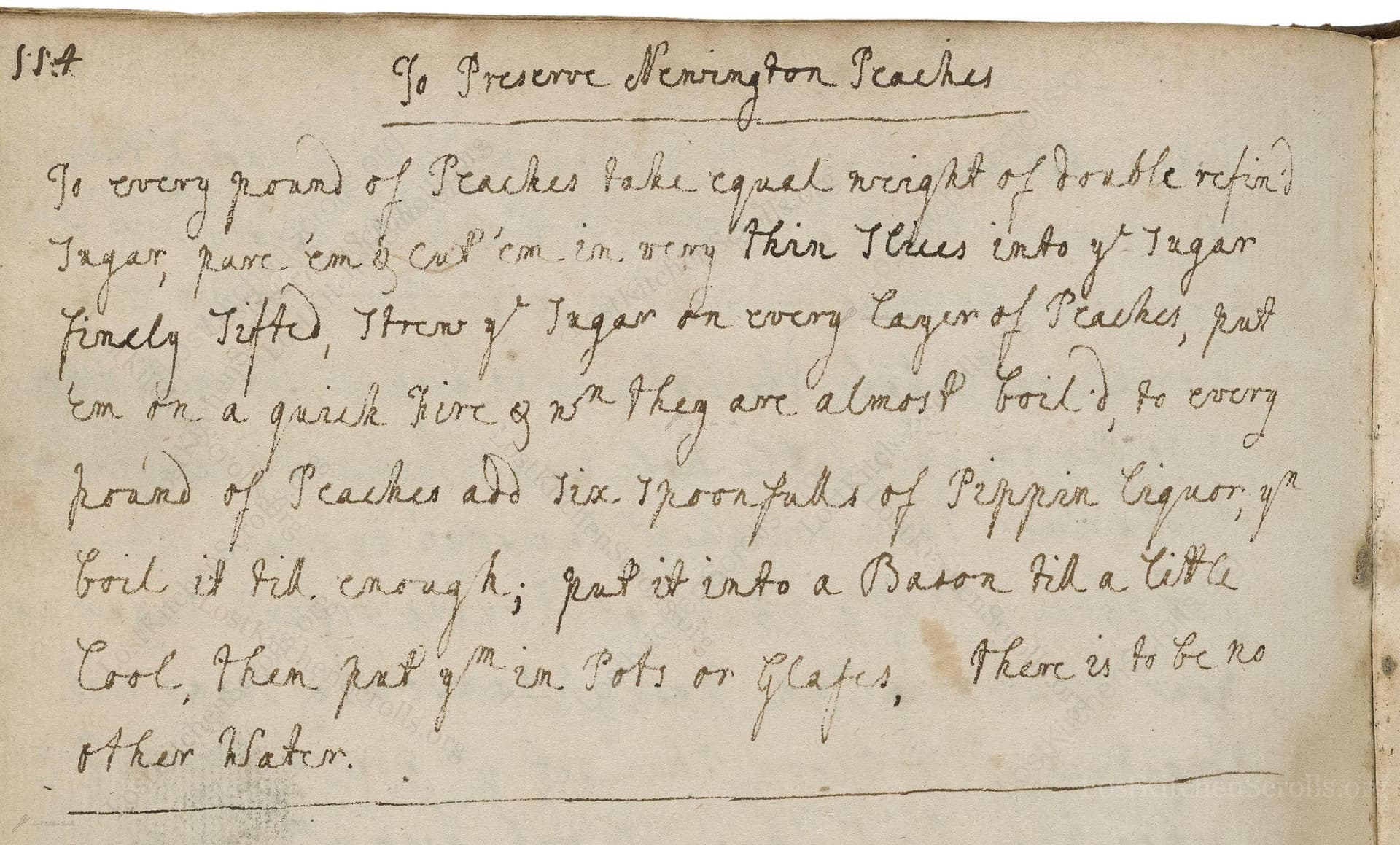To Preserve Newington Peaches
From the treasured pages of Receipt book of Elizabeth Smith
Written by Elizabeth Smith

To Preserve Newington Peaches
"To every pound of Peaches take equal weight of double refin'd Sugar, pare 'em & Cut 'em in very thin Slices into ye Sugar finely sifted, Throw ye Sugar on every Layer of Peaches, put 'em on a quick Fire & when they are almost Boil'd, to every pound of Peaches add six spoonfuls of Pippin Liquor, & Boil it till enough, put it into a Bason till a little Cool, Then put ym in Pots or Glaſses. There is to be no Other Water."
Note on the Original Text
The original recipe is written in the direct, pragmatic style common in eighteenth-century manuscripts, meant for readers already skilled in the kitchen. Quantities are given by weight, without a list of ingredients, and instructions are embedded within the sentence. The term 'double refin'd Sugar' signals highly processed white sugar, while 'Pippin Liquor' indicates sour apple juice. Spellings like 'pare 'em & Cut 'em' reflect casual contractions and variable orthography of the period. 'No Other Water' emphasizes the importance of pure ingredients, relying solely on fruit and sugar for preservation—a mark of both technique and status.

Title
Receipt book of Elizabeth Smith (1775)
You can also click the book image above to peruse the original tome
Writer
Elizabeth Smith
Era
1775
Publisher
Unknown
Background
Step into the refined kitchens of the late 18th century with Elizabeth Smith, whose culinary wisdom offers a charming taste of Georgian elegance and time-honored recipes to delight any palate.
Kindly made available by
Folger Shakespeare Library
This recipe comes from Elizabeth Smith, an eighteenth-century cook active between 1749 and 1800 in Britain. At the time, preserving fruit in sugar was a luxury reserved for those who could afford large amounts of costly refined sugar. 'Newington' refers to a then-popular white peach variety, though any similarly delicate English peach can be used. The inclusion of 'Pippin Liquor'—the juice of tart 'pippin' apples—provided acidity and balance to the sweetness, avoiding the addition of plain water, which could dilute flavor or encourage spoilage. Such preserves would be stored in glass jars or ceramic pots for winter enjoyment, a symbol of both thrift and refinement.

Historically, cooks would have used a sharp paring knife for peeling, a heavy brass or copper preserving pan set over a wood or coal fire, and long-handled wooden spoons for stirring. Sugar would be pounded and sifted through a fine sieve. Once cooked, preserves would be ladled into glazed earthenware pots or hand-blown glass jars ('glasses'), covered with parchment or leather, and sometimes sealed with wax or bladder. No thermometers or mechanical extractors—just practiced skill and watchful eyes.
Prep Time
20 mins
Cook Time
30 mins
Servings
10
We've done our best to adapt this historical recipe for modern kitchens, but some details may still need refinement. We warmly welcome feedback from fellow cooks and culinary historians — your insights support the entire community!
Ingredients
- 2.2 lbs ripe peaches (Newington variety if possible, or any fragrant white peach)
- 2.2 lbs caster sugar (double refined sugar substitute)
- 3 fl oz apple juice (from tart apples, as a replacement for 'Pippin Liquor')
Instructions
- To preserve Newington peaches in the style of Elizabeth Smith's late eighteenth-century recipe, begin by peeling and thinly slicing fresh peaches.
- Weigh your prepared peaches and measure out an equal amount of refined (white) sugar, ideally by weight (for example, 2.2 lbs of peaches to 2.2 lbs of caster sugar).
- In a large, heavy-bottomed pot, layer the peach slices and sugar, sprinkling sugar over each layer.
- Let this sit briefly to allow some juices to begin to draw out.
- Place the pot over medium-high heat ('a quick fire') and bring the fruit and sugar mixture to a steady boil, stirring gently.
- When the mixture is nearly fully cooked (after about 10-15 minutes, when the peaches are soft but still hold their shape), add for every 2.2 pounds of peaches about 6 tablespoons (3 fluid ounces) of apple juice (as a substitute for 'Pippin Liquor', an acidic apple juice).
- Continue to boil until the syrup thickens and the peaches become translucent, around 5-10 minutes more.
- Remove from heat and allow to cool slightly before spooning into sterilized jars or preserving glasses, sealing while still warm.
- No additional water is needed for this preserve.
Estimated Calories
180 per serving
Cooking Estimates
It will take you about 20-30 minutes to cook the peaches with sugar and apple juice until they are clear and syrupy. Prep time includes peeling, slicing, and layering the peaches, which takes about 20 minutes. Each serving has an estimated 180 calories. The recipe makes about 10 servings.
As noted above, we have made our best effort to translate and adapt this historical recipe for modern kitchens, taking into account ingredients nowadays, cooking techniques, measurements, and so on. However, historical recipes often contain assumptions that require interpretation.
We'd love for anyone to help improve these adaptations. Community contributions are highly welcome. If you have suggestions, corrections, or cooking tips based on your experience with this recipe, please share them below.
Join the Discussion
Rate This Recipe
Dietary Preference
Main Ingredients
Culinary Technique
Occasions

Den Bockfisch In Einer Fleisch Suppen Zu Kochen
This recipe hails from a German manuscript cookbook compiled in 1696, a time whe...

Die Grieß Nudlen Zumachen
This recipe comes from a rather mysterious manuscript cookbook, penned anonymous...

Ein Boudain
This recipe comes from an anonymous German-language manuscript cookbook from 169...

Ein Gesaltzen Citroni
This recipe, dating from 1696, comes from an extensive anonymous German cookbook...
Browse our complete collection of time-honored recipes



